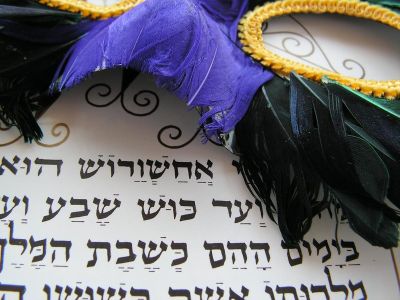Rabbi Oded Peles offers a fresh perspective on Purim by revealing unexpected spiritual ties with Yom Kippur. In his commentary for the Heschel Center at the Catholic University of Lublin, he stressed that while Purim commemorates the rescue of the Jewish people from ancient Persian persecution through festive customs and charity, its true significance lies in unveiling hidden truths.
"The origin of Purim is found in the Book of Esther, where fate—'pur' or lots—plays a decisive role," Rabbi Peles said, noting that "for that reason, these days were named Purim, after pur." He explained that unlike Yom Kippur, a day marked by fasting, prayer, and overt divine acknowledgment, Purim conceals the divine hand behind celebrations, costumes, and feasting. The rabbi observed that while Purim is celebrated with joyous community events, it also serves as a moment for spiritual reflection, as it symbolically reaffirms the acceptance of the Torah during the days of King Ahasuerus.
Peles highlighted that the contrast between the two holidays is striking: Yom Kippur's solemnity invites adherents to seek forgiveness and introspection, whereas Purim, through its outward exuberance, subtly reveals God's hidden presence in everyday life. "On Purim, we are invited to see the concealed hand of God," he added, drawing attention to the mystical interpretations found in Midrash and Kabbalah, which connect the hidden nature of divine intervention with Esther's narrative.
The rabbi also recalled a Midrashic link in which the heroine's name echoes the divine vow to "hide My face," suggesting that both celebrations, despite their contrasting moods, guide the faithful toward a closer encounter with the sacred. This teaching underscores that spirituality can emerge from both exuberant celebration and reflective solemnity, offering a balanced path to understanding the interplay between the seen and unseen in Jewish tradition.
The Heschel Center at the Catholic University of Lublin
The complete commentary follows:
The origin story of the festival of Purim, a holiday which is not mentioned in the Torah (the five books of Moses), can be found in the Bible in the Book of Esther. Purim is celebrated with four main Mitzvot (laws observed): Reading the Megillah (the Book of Esther), Giving gifts to the poor, Exchanging food packages with friends, and enjoying a festive meal.
Purim commemorates the salvation of the Jewish people from genocide in ancient Persia. The festival is characterized by joyous celebrations, costumes, and festive meals, as well as social and communal support, such as caring for the needy by giving charity and special gifts to friends and neighbors.
Surprisingly enough, the sages in the Midrash, as well as the Kabbalists (Jewish mystics), are drawing an unexpected connection between Purim and the holiest day in the Jewish calendar – Yom Kippur (Day of Atonement). Yom Kippur is characterized by a complete focus on the spiritual, setting aside physical needs and worldly concerns. It is a holiday of fasting, praying, and seeking forgiveness for our sins.
Purim and Yom Kippur seem like complete opposites, yet these two holidays share a profound connection. How so? There are a few very interesting links between the two. There is a linguistic connection: The Hebrew word Purim derives from pur, meaning 'lots,' referring to Haman's plan to kill the Jews. As in the Book of Esther (9, 26): "For that reason, these days were named Purim, after pur."
Yom Kippur or Yom Kippurim (Day of Atonement) bears within it the word Purim. In the Book of Esther, the "luck of the draw" prevails. However, God is notably absent. Despite being part of the Bible, God's name is not mentioned in the Book of Esther. The divine presence works behind the scenes, orchestrating salvation through seemingly natural events. A Midrashic reading of its heroine's name, "Esther," recalls the divine vow (Book of Deuteronomy 31, 18): "haster astir panai," or "I [God] surely will hide My face."
Furthermore - Mordechai's reference to help coming to the Jewish people "from another place" (Esther 4:14) is interpreted by the sages as an indirect reference to God. Unlike Purim, on Yom Kippur, God's presence is explicitly acknowledged and central to the day's observance. Another connection between the holidays is the receiving of God's word - the Torah. On Yom Kippur, Moses ascended Mount Sinai to receive the 2nd set of the 'tablets of the covenant' with the Ten Commandments (Book of Exodus 34,4).
On Purim, based on the verse "The Jews fulfilled, and they accepted upon themselves and upon their seed…" (Book of Esther 9, 27) - the sages of the Talmud (Tractate Shabbat pg. 98a) teach that the Jewish people accepted the Torah once again during the days of King Ahasuerus. Nevertheless, this time, they did so out of complete contentment, devotion, and love to God!
Those connections reveal a deeper spiritual truth: both holidays are about revealing what is hidden. On Purim, God's presence is concealed behind natural events, while on Yom Kippur, the divine presence is openly manifest. Yet both holidays achieve the same goal - bringing us closer to God Almighty.
On Purim, through joy and celebration, costumes, drinking, and feasting, we are invited to reveal the hidden hand of God in everyday mundane life. On Yom Kippur, through solemn introspection, fasting, and refraining from all bodily pleasures, we are invited to reveal the hidden depths of our souls.
The interplay between these holidays reminds us that the sacred can be found in both celebration and solemnity, in both the hidden and the revealed. It teaches that spiritual truth often comes in unexpected packages, whether wrapped in the costume of a Purim celebration or the holiness of Yom Kippur.

